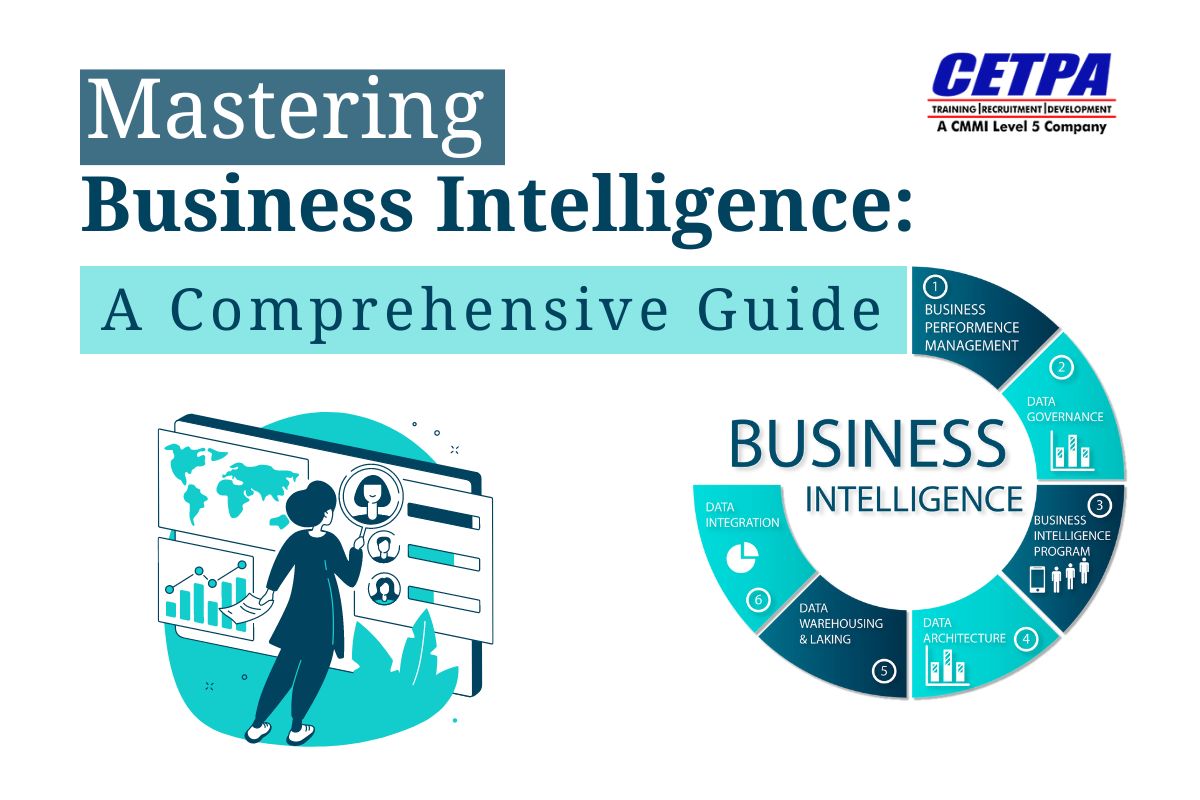Mastering Business Intelligence: A Comprehensive Guide

In the modern business world, characterized by limitless amounts of data and rapid technological advancements, the importance of Business Intelligence (BI) cannot be overstated. Data has transformed from being just a byproduct of operations to the vitality of strategic decision-making. As introduced in our renowned Business Intelligence Training in Noida, BI serves as the link through which businesses can tap into the wealth of information to acquire actionable insights that drive innovation and promote growth. In simple terms, BI involves a range of tools, methodologies, and practices aimed at extracting, analyzing, and presenting data in a meaningful manner. Its components vary from data warehousing and integration to advanced analytics and visualization strategies. However, BI is more than just a collection of technologies; it demonstrates a paradigm shift in how organizations approach data-driven decision-making.
Therefore, by embracing BI best practices, businesses can break down data silos, democratize access to information, and promote a culture of data-driven decision-making at all levels. Additionally, BI allows organizations to stay agile and responsive in the face of changing market dynamics, empowering them to identify upcoming trends, capitalize on opportunities, and eliminate risks efficiently. With the help of this thorough guide, we will examine the many facets of business intelligence (BI) and delve deeply into its complexities to uncover its revolutionary potential for promoting organizational success in the data-driven business environment of today.
Understanding Business Intelligence:
As discussed in Best Business Intelligence Training Institute, Business Intelligence serves as the bedrock of modern decision-making processes within organizations. At its base, BI involves a comprehensive set of technologies, applications, and practices crafted to use the power of data. It begins with the collection of data from different sources, including internal systems, external databases, and even unstructured sources such as social media and sensor data. Once collected, BI allows for the integration of this disparate data into a cohesive and well-organized dataset. Through this process, data silos are broken down, and a holistic view of the business’s operations, performance, and environment emerges. This integrated dataset serves as the basis for analysis, allowing stakeholders to unleash hidden patterns, correlations, and insights.
For Read Also: Tableau vs Power Bi Choosing The Right Data Visualization Tool
Further, as per the business intelligence training program, the actual value of BI stands out during the analysis phase. In this particular phase, advanced analytical strategies are applied to convert raw data into actionable insights. Whether through descriptive analytics, diagnostic analytics, predictive analytics, or prescriptive analytics, BI empowers businesses to understand past performance, diagnose issues, forecast future outcomes, and prescribe optimal courses of action. In a nutshell, BI allows the presentation of these insights in a clear, concise, and accessible manner. With interactive dashboards and visualizations, stakeholders at all levels of organizations can navigate data, acquire knowledge, and make informed decisions. This democratization of data guarantees that decision-makers across organizations have the information they require to drive innovation, optimize processes, and maintain a competitive edge in the current dynamic business environment.
Business Intelligence Training: Navigating The Components of Business Intelligence
Business Intelligence (BI) comprises several components, including analytics to derive insights, data visualization to display information, data warehousing to store data centrally, and data integration to combine different data sources. Every element is essential to enabling firms to use data for strategic planning and decision-making. The various components of business intelligence are listed below for further reference:
Data Warehousing:
Centralized archives that store structured and unstructured data from various sources, guaranteeing data consistency and accessibility.
Data Integration:
Processes for integrating data from multiple sources, like databases, applications, and spreadsheets, into a unified view for analysis.
Data Analytics:
Approaches for evaluating data to unleash patterns, correlations, and trends, including descriptive, diagnostic, predictive, and prescriptive analytics.
Data Visualization:
Tools for showcasing data visually through charts, graphs, dashboards, and interactive reports, improving comprehension and decision-making.
Best Practices for Implementing The Knowledge Imparted in Business Intelligence Training
The best practices for implementing the knowledge of Business Intelligence as introduced in renowned Business Intelligence training programs are:
Defining Clear Objectives:
Individuals must establish clear objectives and key performance indicators (KPIs) that align with their organization’s strategic priorities.
Data Quality Assurance:
Specialists must guarantee data accuracy, completeness, and consistency through data cleansing, validation, and governance practices.
User-Centric Design:
Professionals must design intuitive interfaces and interactive visualizations curated to the requirements of different user groups, promoting adoption and usability.
Continuous Improvement:
Individuals must embrace a culture of continuous learning and adaptation, using feedback and insights to refine BI solutions over time.
Exploring The Innovative Applications of Business Intelligence
The most innovative applications of business intelligence as introduced in our popular business intelligence training course are:
Predictive Analytics for Forecasting:
This involves utilizing advanced statistical models and machine learning algorithms to forecast future trends, customer behaviour, and market dynamics, allowing proactive decision-making and risk management.
Real-Time Monitoring and Alerts:
It encompasses the implementation of monitoring dashboards and automated alerting systems to detect anomalies, performance deviations, and upcoming opportunities or threats in real time.
AI-Powered Insights Generation:
It includes harnessing the power of artificial intelligence (AI) and natural language processing (NLP) to automate data analysis, generate insights, and answer ad-hoc queries through conversational interfaces and chatbots.
Augmented Reality (AR) for Data Visualization:
This specific application explores immersive data visualization techniques using AR technology to interact with data in 3D space. It allows deeper insights and collaboration among stakeholders.
Conclusion:
Businesses trying to negotiate the intricacies of today’s business environment rely heavily on business intelligence (BI). Its complexity is beyond simple data analysis; rather, it is a strategic necessity for realizing the full value of data assets. Businesses can set themselves apart in their respective industries by using BI best practices and embracing cutting-edge technologies. Further, gaining a competitive advantage is one of the main benefits of becoming proficient in BI. Organizations can obtain profound insights into consumer behaviour, market trends, and competitive environments by conducting thorough data analysis. Equipped with this understanding, they may make well-informed choices, streamline procedures, and seize new possibilities ahead of their rivals.
Furthermore, BI acts as an innovation accelerator, pushing businesses to forge ahead with cutting-edge problem-solving techniques and investigate uncharted territory. Businesses can discover hidden trends, forecast future results, and investigate alternative scenarios by utilizing sophisticated analytics, machine learning, and AI. This encourages experimentation and creativity. Moreover, sustainability is critical in the fast-paced business world of today, and business intelligence (BI) is essential to long-term progress. Organizations can enhance profitability and resilience to economic uncertainty by identifying inefficiencies. This further streamlines operations and more effectively allocates resources by utilizing data-driven insights. Nevertheless, being an expert in BI calls for a dedication to ongoing development and adaptation. As new technology and methods emerge, organizations need to stay flexible, responsive, and willing to adopt them. Additionally, prioritizing user-centric designs guarantees that BI solutions are understandable, reachable, and user-friendly, maximizing adoption and producing measurable business results.
To sum up, having a solid understanding of business intelligence is essential for surviving in the digital age. This means that the knowledge of business intelligence is not just meant to give oneself a competitive edge. Organizations can leverage the transformative power of business intelligence to propel innovation, agility, and sustainable growth through strategic approach adoption. This thereby establishes them as leaders within their respective industries.
So, what are you still holding out for? Join our business intelligence training program today and advance your career to new heights!
Tag:Best Business Intelligence Certification Course, Best Business Intelligence Course, Best Business Intelligence Training, Best Business Intelligence Training Institute, Business Intelligence Certification Course in Noida, Business Intelligence Course in Noida, Business Intelligence Online Course, Business Intelligence Online Training, Business Intelligence Training in Noida, CETPA Infotech



